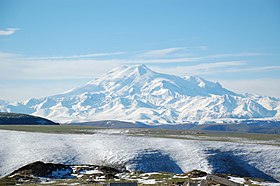Einsame Maria
| Einsame Maria | |
|---|---|
| Txol'ulk'Alara | |
 The Einsame Maria in the summer; the mountain is permanently snowcapped. | |
| Highest point | |
| Peak | the Virgin's Throne (der Jungfrauthron) |
| Elevation | 5,734 m (18,812 ft) |
| Listing | Kupferberg Country high point |
| Naming | |
| Etymology | Named after the Virgin Mary, einsame ("lone") referring to the peak's prominence |
| Native name | [Txol'ulk'Alara] Error: {{Native name}}: unrecognized language tag: Mountaineer (help) (language?) |
| English translation | 'the mountain where Alara dwells' |
| Geography | |
| Country | |
| Province | Kupferberg |
| Parent range | Kupferberg Mountains |
| Geology | |
| Mountain type | Stratovolcano |
| Type of rock | Metamorphic and igneous rock, principally gneiss and rhyolite |
| Last eruption | 275 BC ± 10 years |
| Climbing | |
| First ascent | 23 May 1882 |
| Access | Ministerial permit required, <10 granted per year |
The Einsame Maria (the Lone Maria), also known in Mountaineer as Txol'ulk'Alara (the mountain where Alara dwells) is the largest mountain in Hendalarsk and one of the largest mountains in Levantia. A dormant stratovolcano whose last significant eruption occurred around 2300 years ago, the Einsame Maria is an iconic symbol of Hendalarsk both domestically and internationally and is revered in various cultural and religious traditions across the nation.